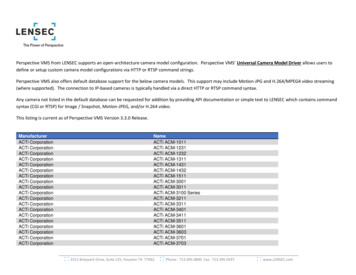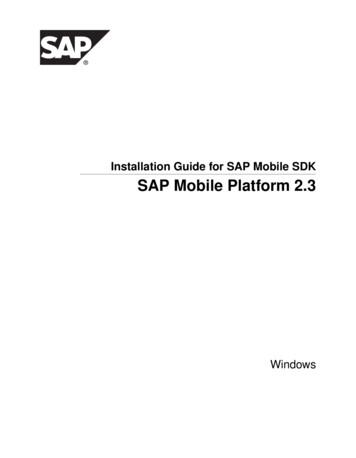3G/4G Mobile Communications Systems
3G/4G Mobile Communications SystemsDr. Stefan BrückQualcomm Corporate R&D Center Germany
Chapter I:2History of Mobile Communicationsand StandardizationSlide 2
History of Mobile Communications and Standarization History of Wireless/Mobile Communications History of Standardization Evolution of Mobile Communcation Systems Service/Network Evolution Mobile Communication Roadmaps (A look into the future)3Slide 3
History - Definition of Wireless and Mobile Wireless Communication without wires, can either be mobile or fixed Mobile Portable devices (laptops, notebooks etc.) connected at different locationto wired networks (e.g. LAN ) Portable devices (phones, notebooks, PDAs etc.) connected to wirelessnetworks (UMTS, GSM, WLAN .)4Slide 4
History – Wireless Communications I Many people in history used light for communication Heliographs, flags („semaphore“), . China, Han-Dynasty (206 BC – 24 AC)signalling towers 150 BC smoke signals for communication;(Polybius, Greece) 1794, optical telegraph, Claude Chappe Beginning of communications with electromagnetic waves 1831 Faraday demonstrates electromagnetic induction J. Maxwell (1831-79): theory of electromagneticfields, wave equations (1864) 1876 telephone, Alexander Graham Bell H. Hertz (1857-94): demonstratesthe wave character of electrical transmissionthrough space (1888, in Karlsruhe)5Slide 5
History - Wireless Communication II 1895 Guglielmo Marconi First demonstration of wirelesstelegraphy (digital!) Long wave transmission, hightransmission power necessary ( 200kw) 1907Commercial transatlantic connections Huge base stations (30m-100m high antennas) 1915Wireless voice transmission New York - San Francisco 1920Discovery of short waves by Marconi Reflection at the ionosphere Smaller sender and receiver, possible due to the invention of thevacuum tube (1906, Lee DeForest and Robert von Lieben)6Slide 6
History - Mobile Communications 1911 mobile transmitter on Zeppelin 1926 train (Hamburg – Berlin) 1927 first commercial car radio (receive only) First Mobile Communication Systems started in the 40s in the US and in the50s in EuropeCONCEPTS: Large Areas per Transmitter „Mobiles“ large, high powerconsumption Systems low capacity,interference-prone Expensive !!!19247Slide 7
History - 1st Generation Systems High transmitter power( 20 W) in base- and mobilestation Large cells with wide range(radius ca. 150 km) Low infrastructure-cost Low subscriber-capacity Low frequency economy8Slide 8
History - A/B-Netz in Germany A-Netz (1958-1977) 160 MHz 1971 80% Coverage11000 Subscriber B-Netz (1972-1994),Der Abschied von ABC- Eine Zeitreise zu den wichtigstenStationen, Broschüre der T-Mobil, www.handy-sammler.de Germany, Austria, Luxemburg 1979 13 000 Subscriber, heavy „Mobiles“ mainly in cars Beginning of the 80s 1 Mio. Subscribers worldwide9Slide 9
History- Cellular Communication Networks Rapid semi-conductor and microprocessor development Bell Labs: Patent for cellular networks, 1972 Small coverage areas with variable cell radiusLess transmitter powerFrequency reuse, clusteringHand-over Smaller and cheaper user equipment Higher network capacity High costs for infrastructure Typical networks:Quelle: B. Walke, M.P. Althoff, P.Seidenberg, UMTS – EinKurs, Weil der Stadt 2001, Figure 2.2 , p. 15 NMT in Scandinavia (1979) AMPS in the US (1983) C-Netz in D, A, CH (1985-2000) 1990 ca. 20 million subscriberworld-wideEricsson Hotline 900630 gr !NMT-900, 198710Slide 10
History – 2nd Generation Mobile Systems Requirement: Higher system capacity, higher data rates Digital Transmission to improve system capacity, coverage and QoS International Roaming Voice is the dominating application but systems are capable of fax,data, SMS, MMS, Typical Networks (since 1990):IS-95 (US), D-AMPS (US), PDC (Japan) and GSMMotorola International 1000www.handy-sammler.de/Museum/13.html11Slide 11
History- Systems of the 2nd Generation IS-54 (D-AMPS) Follower of the analog AMPS in America Timeslot structure IS-136 (Digital PCS) Further development of IS-54 IS-95 and IS-95b (cdmaOne) based on N-CDMA (1.23MHz Bandwidth) first commercial CDMA-Net PDC (Personal Digital Cellular) particularly in Japan broadened12Slide 12
History of GSM 1982: The main governing body of the European PTTs (CEPT) set up acommittee known as Groupe Special Mobile (GSM) to define adigital mobil cellular system that could be introduced acrossEurope by the 1990s. PTT: Post, Telegraph and Telephone Administrations CEPT: European Conference of Postal Telecommunications Administrations The CEPT allocated the neccesary duplex radio frequency in the 900 MHz region. 1987: The main transmission techniques are chosen based on prototypeevaluation 1990: The Phase 1 GSM900 specifications are frozen, DCS1800adaptation begins 1992: GSM (renamed Global System for Mobile Communications) wentoperational in various European countries Today: Around 1 billion subscribers in more than 200 countries useGSM-based systems13Slide 13
The Creation of 3GPP Mid to end of the nineties the standardization of 3rd generation mobilecommunications systems took place in several regions around the world Common to all of them was the focus on CDMA based technologies To ensure equipment compatibility and to increase working efficiency,initiatives were made to create a single forum for WCDMA standardization These initiatives resulted in the creation of the 3rd Generation PartnershipProject (3GPP) in December 1998 Standardization organizations firstly involved were ARIB (Japan), ETSI (Europe),TTA (Korea), TTC (Japan) and T1P1 (USA) In 1999, also CWTS (China) joined 3GPP The detailed technical work in 3GPP was started early 1999 with the aim ofhaving a common specification ready by the end of 199914Slide 14
What is 3GPP? 3GPP stands for 3rd Generation Partnership Project3GPP is a collaboration agreement, established in December 1998, to ensurea worldwide acceptance of 3G W-CDMA/UMTS standardsIt is a partnership of 6 regional SDOs (standard development organization)S.KoreaEuropeUSAChinaJapan These SDOs take 3GPP specifications and transposethem to regional (Europe, North America, Korea, Japan, China) standards ITU references the regional standards “IMT-2000”, “IMT-Advanced”see: www.3gpp.org15Slide 15
3GPP MembersOrganizational Members: ARIB Association of Radio Industries and Businesses, Japan ATIS Alliance for Telecommunications Industry Solutions, USA CCSA China Communications Standards Association, China ETSI European Telecommunications Standards Institute, EU (France)16 TTATelecommunications Technology Association, South Korea TTCThe Telecommunication Technology Committee, JapanSlide 16
3GPP Specification GroupsThis lecture focuses on Radio Access Network Aspects17Slide 17
3G Evolution – Radio Technologies18Slide 18
What is 3G or IMT-2000 The International Telecommunications Union (ITU) defined the keyrequirements for International Mobile Telecommunications 2000 servicesmore commonly known as 3G requirements Improved system capacity, backward compatibility with 2G, multimediasupport and high speed packet data meeting the following criteria 192 Mbps in fixed or in-building environments384 kbps in pedestrian or urban environments144 kbps in wide area mobile environmentsVariable data rates in large geographic area systems (satellite)Slide 19
IMT-Advanced and 4G Wireless Standards IMT-Advanced Requirements Based on an all-IP packet switched network Peak data rates of up to approximately 100 Mbit/s and up to approximately 1 Gbit/sfor low mobility Scalable channel bandwidth, between 5 and 20 MHz, optionally up to 40 MHz Peak link spectral efficiency of 15 bit/s/Hz in the downlink, and 6.75 bit/s/Hz in theuplink System spectral efficiency of up to 3 bit/s/Hz/cell in the downlink and 2.25bit/s/Hz/cell for indoor usage Smooth handovers across heterogeneous networks. Ability to offer high quality of service for next generation multimedia support. Typically, IMT-Advanced and 4G are used synonymously IMT-Advanced Technologies are LTE-Advanced (specified by 3GPP) WiMax – 802.16m (specified by IEEE) WirelessMAN-Advanced, Mobile WiMax Release 2 http://www.itu.int/net/pressoffice/press releases/2012/02.aspx20Slide 20
3G CDMA2000 and UMTS/WCDMA21Slide 21
Where are the 3G Standards? 3GPP (for GSM, UMTS, LTE) www.3gpp.org22 3GPP2 (for CDMA2000) www.3gpp2.orgSlide 22
WCDMA – Data Services23Slide 23
3GPP Mobile Broadband Evolution Path24Slide 24
The Evolution Beyond 201125Slide 25
3GPP Standard Releases – Rel99 to Rel1026VersionReleasedInfoRelease 992000 Q1Specified the first UMTS 3G networks, incorporating aCDMA air interfaceRelease 42001 Q2Originally called the Release 2000 , introduced all-IP CoreNetworkRelease 52002 Q1Introduced IMS and HSDPARelease 62004 Q4Integrated operation with Wireless LAN networks and addsHSUPA, MBMS, enhancements to IMSRelease 72007 Q4Focuses on decreasing latency, improvements to QoS andreal-time applications such as VoIP. This specification alsofocuses on HSPA Release 82008 Q4First LTE release. All-IP Network (SAE). New OFDMA, andMIMO based radio interface, not backwards compatible withprevious CDMA interfaces. Dual-Cell HSDPA.Release 92009 Q4SAES Enhancements, WiMAX and LTE/UMTS Interoperability. Dual-Cell HSDPA with MIMO, Dual-Cell HSUPA.Release 102011 Q1LTE Advanced fulfilling IMT Advanced 4G requirements.Backwards compatible with Release 8 (LTE). Multi-CellHSDPA (4 carriers).Slide 26
3GPP Standard Releases – Rel11 to Rel1227VersionReleasedInfoRelease 11In progressFurther enhancements for heterogeneous networks for LTE(FeICIC), Downlink Cooperative Multipoint in LTE (CoMP),Eight carrier HSDPA, 4x4 HSDPA MIMO, 64QAM 2x2HSUPA MIMORelease 12Not startedDiscussions are ongoing what to includeSlide 27
The 3GPP History of a Decade28Slide 28
Facts and Numbers (Source: 4G Americas) 423 HSPA networks are in service in 160 countries in February 2012 373 HSPA networks are in service in 150 countries in December 2010 184 HSPA networks are in service in 94 countries in February 2012 97 HSPA networks are in service in 52 countries in December 2010 55 LTE networks are in service in 34 countries in February 2012 14 LTE networks are in service in 10 countries in December 2010 Market Share and Forecast to 201629Slide 29
Total Mobile Network Data Traffic Forecast30Slide 30
PPT Figures31
The 3GPP History of a DecadeR8DL OFDMUL SC-FDMADL 4x4 MIMOUL MU-MIMOUL Shared ChannelFrequency-Selective SchedulingFlexible Frequency SpectrumEnhanced RAN/Core ArchitectureR5HS DL SharedChannelDL 16QAMDL AMCDL HARQDL Node B SchedulingIMSR7DL 2x2 MIMODL 64QAMUL 16QAMDL L2 EnhancementsR9DL Dual LayerBeam FormingR10R11DL 8x8 MIMOUL 2x4 MIMOeICICFeICICCoMPR99R4R6R8R9R10DL/UL CDMADedicated ChannelDL QPSKUL BPSKTurbo Codes5 MHz FrequencySpectrumDL SharedChannelDL RNCSchedulingAll-IP CoreEnh. Ded. ChannelUL QPSKUL AMCUL HARQUL Node B SchedulingMBMSDL 2-CarrierSIMOUL L2EnhancementsDL 2-CarrierMIMOUL 2-CarrierSIMODL 4-CarrierSIMOUL TDLTELTELTE-AHSPA HSPA HSPA UMTS R4UMTS R9919992000HSDPA20012002UMTS R99HSUPA20032004HSPA 2005HSDPA20062007HSUPA20082009R7 HSPA 20102011R8 HSPA R8 LTEEDGEFirst Deployments32Slide 32LTEHSPA 2012
Portable devices (phones, notebooks, PDAs etc.) connected to wireless networks (UMTS, GSM, WLAN .) History - Definition of Wireless and Mobile 4 Slide 4. Many people in history used light for communication . Release 99 2000 Q1 Specified the first UMTS 3G networks, incorporating a CDMA air interface Release 4 2001 Q2 Originally called the .
Axis Communications AXIS 215 PTZ-E Axis Communications AXIS 216FD Axis Communications AXIS 216FD-V Axis Communications AXIS 216MFD Axis Communications AXIS 216MFD-V Axis Communications AXIS 221 Axis Communications AXIS 223M Axis Communications AXIS 225FD Axi
Strategy 6: Mobile Workload Mobile devices are increasingly driving mainframe workloads April 2014: Mobile Workload Pricing – 60% reduction in mobile workload CPU to R4HA peak MUST be from mobile device MUST show connection to mobile device – Mobile Safari good – Desktop Safari not good Mobile to mainframe is .
A communications-specific TTX is a forum to evaluate current communications plans, communications concepts, resources, and interoperable capabilities. The emphasis of a communications-specific TTX is on interoperable communications capabilities or gaps; interoperable communications assets in place, or their absence; and the use of
Mobile Communication Services . Offerings Detail Samsung SDS America Public Sector Capabilities Mobile ERP Health IT Mobile Groupware SAP Mobile BI Dashboard Oracle/Siebel Mobile CRM for Pharmaceutical Sales Mobile Device Management Mobile Applications (Android OS) . Android Mobile App & UI. 10 Offerings Detail Conceptual .
Mobile 3G/4G, pushing wireless boundaries to enable the best mobile experiences 2 Mobile connectivity is an amazing technical achievement, 4 critical to the mobile experience Wireless fundamentals are the foundation to mobile powered by Mobile 3G/4G technologies Appreciating the magic of mobile requires un
Mobile advertising helps developers of mobile apps obtain revenue without directly charging users. Therefore, advertising is a key component of the mobile app ecosys-tem. Mobile advertising is typically integrated into mobile apps via an advertising library or SDK (AdSDK), which fetches and displays mobile ads while the app is running.
SAP Mobile SDK or SAP Mobile Server installed, you must provide a license. See Obtaining a License on page 1. If you are installing SAP Mobile SDK on a system where a version of SAP Mobile Platform Runtime is already installed, the SAP Mobile SDK installer installs using the SAP Mobile Server license. See Chapter 2, Installing SAP Mobile SDK on .
Mobile Marketing with Channel Mobile It's time to harness the power of mobile!! The Power of Mobile The Power of Mobile Operator revenues - 5.4 trillion cumulative 2013 - 2017 Analysts predict a SIM penetration of 97% in 2017 Mobile data traffic expected to grow by 79% annually from 2012 - 2017























